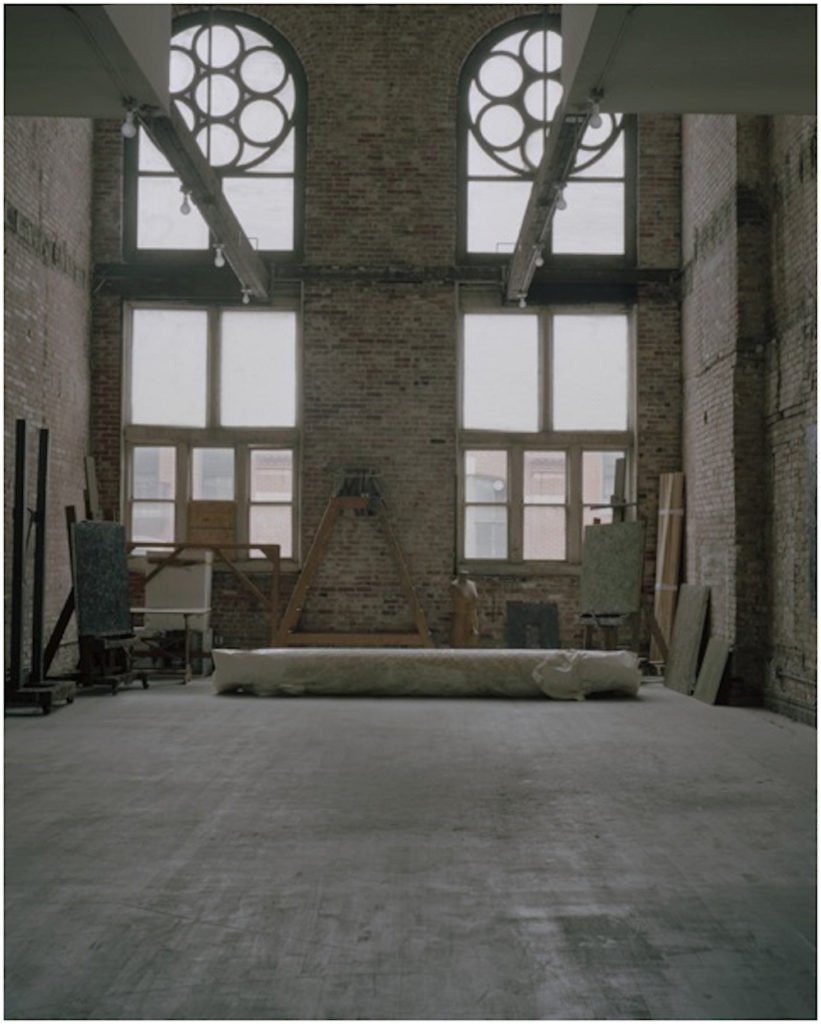

Milton Resnick’s studio in a former synagogue on Eldridge Street. (bron:
The new York Times)

"Its subtle presence on the block spurred plenty of curiousity over the years. Always appearing empty. Not so. The 100-year-old former synagogue at 87 Eldridge Street – the onetime art studio of Milton Resnick – is undergoing an extensive renovation and will open to the public in four months. The timing is right, too, as Grand Street is quickly becoming a gallery mecca.
The late Milton Resnick purchased this lovely piece of Lower East Side history back in 1977. The abstract painter acquired the building fifteen years after his wife, painter Pat Passlof, herself bought the 1874 synagogue around the corner at 80 Forsyth Street (for $20,000). Though married, the two lived, and worked, apart in their respective properties until Resnick committed suiced twelve years ago. Passlof passed in 2011.
A trustee from the Milton Resnick and Pat Passlof Foundation – the nonprofit created in the wake of her death – then sold 80 Forsyth for $6.25 million in 2013. In her will, Passlof asked that this property be sold, with profits to be used to restore 87 Eldridge Street into an “exhibition space and study center” that showcased her husband’s work.
Four years later, it appears the dream is coming true. The restoration project has been ongoing since last October, hidden behind sidewalk shed and construction materials. Apparently, the bulk of the costs went toward installing climate control to keep the art intact."
(bron:
Bowery Boogie)

The interior of 87 Eldridge Street during renovations. (bron:
ArtNews)

(bron:
Ryall Sheridan Architects)

The exterior of the building still bears tell-tale signs of its Jewish ancestry.

Resnick’s third-floor studio, preserved as it was during his time there. (bron:
The Architects Newspaper, foto's: Brian Buckley)


Pat Passlof in her studio in a former synagogue on Manhattan's Lower East Side.


(bron:
The New York Times)


80 Forsyth Street, New York.
"When the green brick synagogue and longtime studio of Abstract Expressionist Pat Passlof came on the market for $6.2 million last spring, it seemed destined for demolition. A mixed use, unlandmarked 7,055-square foot property with an additional 3,000 square feet of air rights in an indisputably hot neighborhood? What could such circumstances possibly lead to but a yet another nail in the coffin of old New York—one more remnant of local character razed to make way for by a few sprawling units of luxury housing with some “bespoke” but utterly bland, Brooklynesque establishment on the ground floor?
Well, the end may still be nigh for New York, but 80 Forsythe Street will live to see another day. The former studio and home of Ms. Passlof, who died in 2011, will be spared the wrecking ball, at least for the time being. The property’s new owner, 80 Forsyth Properties LLC, who paid $6.4 million for the building, intends to use it as a studio/gallery, according to Massey Knakel, who had the listing.
....
The one-time synagogue, built in 1874, still has its original pointed arch windows, which along with the skylights added by Ms. Passlof, flood the building with light, one of the few luxuries.
“They called it a rat hole, but I couldn’t deny that,” Ms. Passlof told a New York Times reporter in 2011, describing her parents’ reaction to the condemned building that she bought in 1963 for $20,000. The synagogue had rodents, but it lacked windows, structurally-sound floors, or a proper foundation.
The couple’s renovation transformed the building into a beautiful if no-nonsense work space, with huge lofted rooms covered in white planking and few interior divisions. As Geoffrey Dorfman, who wrote Out of the Picture: Milton Resnick and the New York School, once told The Times,”If you look at his, and at Pat’s [studio], you can see these are places of work. The chairs are hard. You’re not a serious artist if you’ve got the comfy chairs and the TV you can doze in front of.”
“They did a tremendous amount of work, but they kept it loft-like,” Mr. DeCheser told The Observer. It was not, in other words, a luxury residential renovation, even if many of its features can be found in high-end property listings: double-height ceilings, wood floors, exposed brick, even a fireplace.
...."



(bron:
Observer en
The Lo-Down)
> The Milton Resnick and Pat Passlof Foundation

















































